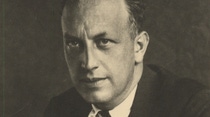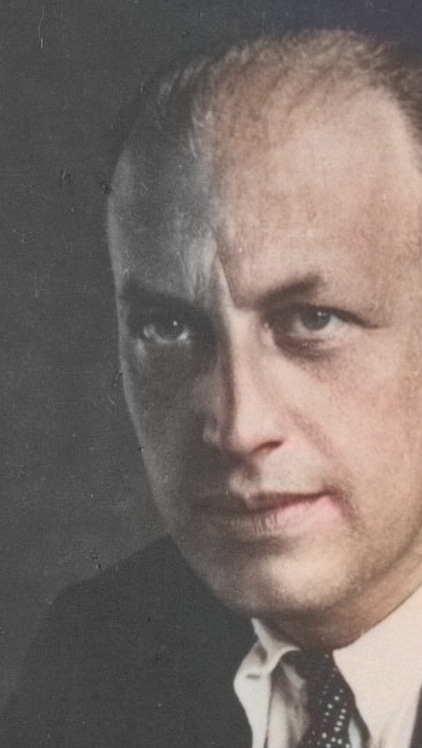Who we are
Dr. Walter Frankenburg - What I am entitled to

Lifetime: 1893-1957
Profession: Chemist
Employment at the plant: 1923-1938
Gounds for discrimination/persecution: Jewish [as per Nazi definition]
Fate: Termination of employment; emigration
By 1935, if not long before, Dr. Walter Frankenburg noticed that his career would suffer as a Jew in Nazi Germany. His surname at the time was Frankenburger – it was only upon his emigration from Germany that he dispensed with the last syllable of his name. He had been employed as a chemist at BASF since 1923, serving for ten years as a group leader in the ammonia laboratory at the Oppau plant. An expert in the field of color photography, his work included research on ammonia catalysis. Frankenburg’s expertise was highly valued. In 1935, he was invited to deliver a lecture to a specialist group meeting of the Verein Deutscher Chemiker (Association of German Chemists). The invitation was unceremoniously withdrawn when members complained about the “non-Aryan speaker.” Racial fanaticism trumped expertise. In retrospect, Frankenburg recalled experiencing such discrimination often, although he claimed to have been spared more severe hostility.
Either way, he fought against the injustices he was to face in the following years. The Frankenburg case would continue to occupy BASF in the post-war years.
Refusal to be sidelined
Walter Frankenburg, his non-Jewish wife and their two sons felt increasingly unsafe in Germany. He wanted to start a new life in the USA as quickly as possible. In July 1938, he approached his managers, first verbally, then in writing. Looking back, he justified his decision as follows: “In 1938, my sons were reaching an age in which they started to feel discriminations against them as ‘half-Aryans.’ At the same time, I realized that any hope for a change of the Hitler regime to a better system was merely wishful thinking.”
Walter Frankenburg was invited to a meeting. A memo in May 1938 suggested that his Jewish heritage was already at odds with the company’s compliance with the Nazi government’s mandates:
As I just heard, Dr. Frankenburger is again at the film plant [in Wolfen] today to discuss his color process. I would draw your attention to the following: We no longer have any Jews at our plants, and I cannot allow any Jews into our plant [in Wolfen] in the future, as we would immediately be reported to the police, as has already happened several times.
Knowing that Walter Frankenburg could not remain, it was also noted that “Dr. F. continues to collect documents at various places, which he will undoubtedly use later with a rival company, something I cannot even hold against him. We should therefore do everything possible to effectively ‘sideline’ Dr. Frankenburger.”
However, treading water was not in Frankenburg’s character. On July 14, 1938, he discussed options for his departure with Carl Wurster and his line manager, Hans Grimm, the longstanding head of the ammonia laboratory. The record states that the company was unable to provide support for his “intended trip to America,” either financially or by means of a “letter of introduction.” However, Walter Frankenburg later recalled that a severance payment was discussed.
A new job on the horizon
Hans Grimm, in particular, offered his longstanding colleague support. He tried to secure him a position with one of the US subsidiaries of I.G. Farben, especially Agfa-Ansco. This suited Frankenburg well. In September 1938, he finally traveled to the United States at his own expense, initially staying with relatives in New York. To help him gain a work permit and allow him to start working for Agfa-Ansco sooner, he planned to re-enter the United States via Cuba. However, he still had to wait until April or May 1939 before receiving his work permit. Meanwhile, in Ludwigshafen, it was assumed that Frankenburg would secure a position at Agfa-Ansco after immigrating to the US.
This suddenly raised the question of whether Frankenburg should receive any severance pay at all in this case. From the perspective of the Ludwigshafen plant, if Frankenburg were to gain permanent employment at Agfa-Ansco, the key requirement for the severance payment of 40,000 RM would no longer apply, as revealed in a November 1938 memo. Nonetheless, in December 1938, an agreement was reached to terminate the employment relationship amicably at the end of the year – even though the details of his departure had not yet been finalized. In hindsight, the ensuing disputes over these issues did not come as a surprise.
To compensate or not to compensate?
The Frankenburg family soon felt that they had been duped on the issue of severance pay. “It was news to me that my husband would have no claims for severance pay if he found employment within the I.G. group. I telegraphed my husband about this today," wrote his wife, Elisabeth. Her husband promptly replied: “No such agreement made. Relevant companies not I.G. Entirely American. Employment there still highly uncertain. Compensation would be a mere fraction. Am I to be forced to work for a foreign company? I relied on loyalty.” In June 1939, Walter Frankenburg was informed that he would receive severance pay of 10,000 RM, based on the assumption that he seemed poised to find “lifelong employment” in the United States. This amount was just a quarter of what he had expected.
Walter Frankenburg refused to accept this, especially since he never managed to secure a position at Agfa-Ansco. He clung to the verbal assurance of 40,000 RM he recalled being offered on July 14, 1938. The conflicting interpretations of this matter became the subject of a lengthy post-war legal dispute between BASF and Frankenburg, which was eventually resolved by means of a settlement in 1953. Frankenburg’s remaining claim of 30,000 RM was converted and reimbursed as 3,000 DM. It is currently not possible to reconstruct where Walter Frankenburg finally found employment – certainly not at Agfa-Ansco. He reportedly became the director of a scientific laboratory at a US tobacco company and passed away in the United States in 1957.


